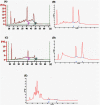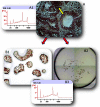Comparison of five different RNA sources to examine the lactating bovine mammary gland transcriptome using RNA-Sequencing
- PMID: 25001089
- PMCID: PMC5381611
- DOI: 10.1038/srep05297
Comparison of five different RNA sources to examine the lactating bovine mammary gland transcriptome using RNA-Sequencing
Abstract
The objective of this study was to examine five different sources of RNA, namely mammary gland tissue (MGT), milk somatic cells (SC), laser microdissected mammary epithelial cells (LCMEC), milk fat globules (MFG) and antibody-captured milk mammary epithelial cells (mMEC) to analyze the bovine mammary gland transcriptome using RNA-Sequencing. Our results provide a comparison between different sampling methods (invasive and non-invasive) to define the transcriptome of mammary gland tissue and milk cells. This information will be of value to investigators in choosing the most appropriate sampling method for different research applications to study specific physiological states during lactation. One of the simplest procedures to study the transcriptome associated with milk appears to be the isolation of total RNA directly from SC or MFG released into milk during lactation. Our results indicate that the SC and MFG transcriptome are representative of MGT and LCMEC and can be used as effective and alternative samples to study mammary gland expression without the need to perform a tissue biopsy.
Conflict of interest statement
This project was partially funded by the France Berkeley Fund (
Figures


References
-
- Capuco A. V., Wood D. L., Baldwin R., McLeod K. & Paape M. J. Mammary cell number, proliferation, and apoptosis during a bovine lactation: relation to milk production and effect of bST. J Dairy Sci 84, 2177–2187 (2001). - PubMed
-
- Huston G. E. & Patton S. Factors related to the formation of cytoplasmic crescents on milk fat globules. J Dairy Sci 73, 2061–2066 (1990). - PubMed
-
- Boutinaud M. & Jammes H. Potential uses of milk epithelial cells: a review. Reprod Nutr Dev 42, 133–147 (2002). - PubMed
-
- Medrano J. F., Rincón G. & Islas A. D. Comparative analysis of bovine milk and mammary gland transcriptome using RNA-Seq. 9th World Congress of Genetics Applied to Livestock Production (WCGALP), Leipzig-Germany, No. 0852 (2010).
Publication types
MeSH terms
Substances
LinkOut - more resources
Full Text Sources
Other Literature Sources

